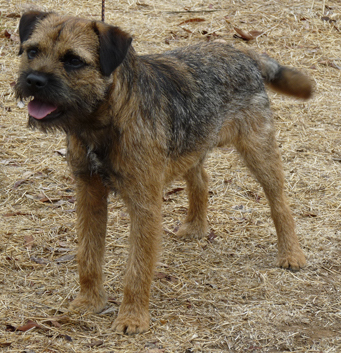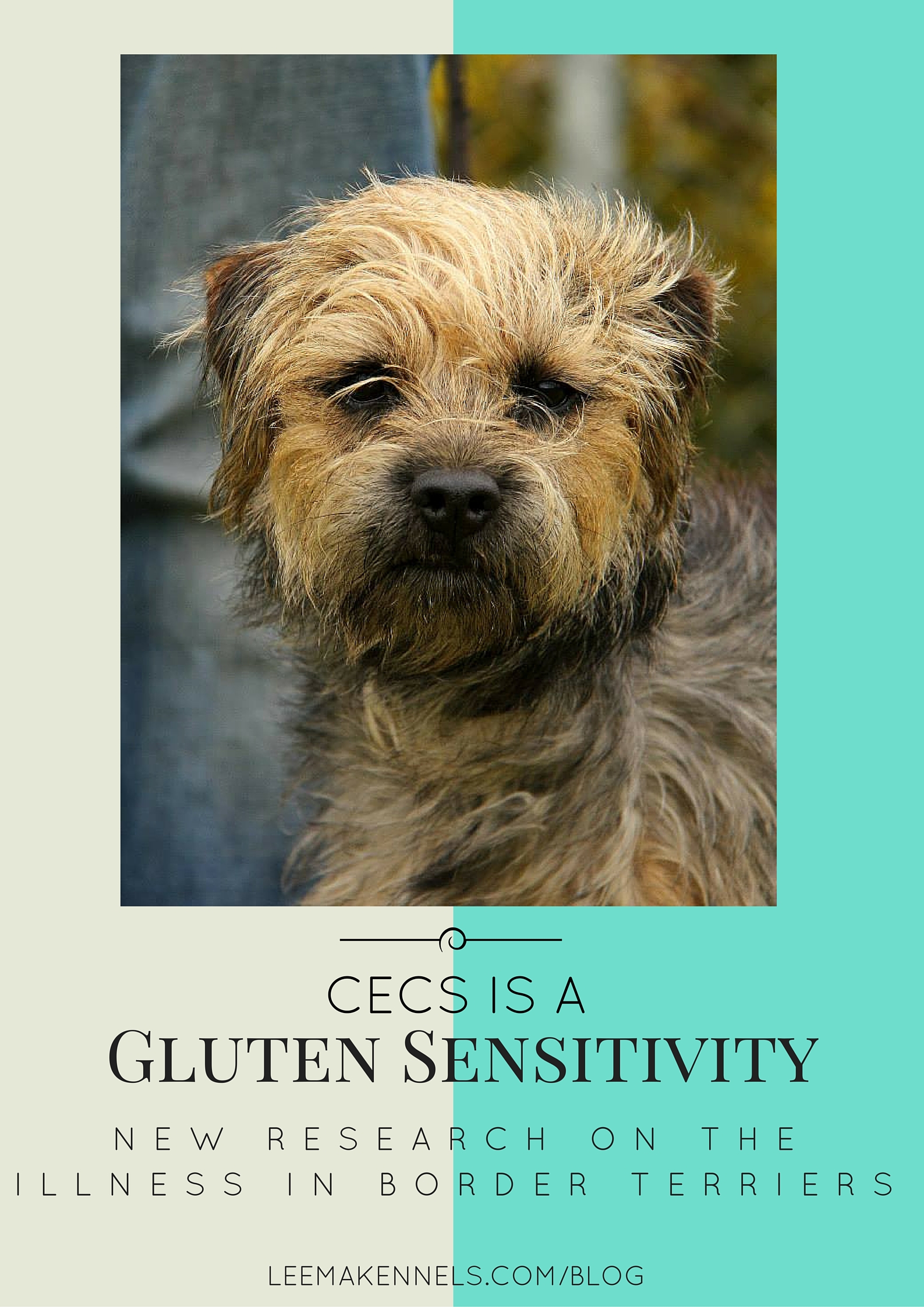CECS is a Gluten Sensitivity
The idea that CECS is a Gluten Sensitivity has been presented by recent research.
They were actually quite confident with the link between the two, saying in the research,
Canine epileptic cramping syndrome in [border terriers]s is a gluten-sensitive movement disorder triggered and perpetuated by gluten and thus responsive to a gluten-free diet.
This is pretty exciting stuff! CECS (short for Canine Epileptoid Cramping Syndrome, or sometimes called ‘Spike’s Disease’) is an unusual condition found almost exclusively in border terriers. These dogs are normal dogs except for when they have an ‘episode’ or a seizure. During an episode, the dog will ‘cramp up’. Typically, they remain conscious, but can’t walk, and sometimes appear worried following an episode.

Chip, a border terrier that does not have CECS
So far, there has been no real diagnostic test or explanation for the condition. In December 2013, a study looked at CECS, but it was an owner-survey, information-gaining exercise. Which is important, but doesn’t give us answers!
It was so important that it actually spurred this research. In the December 2013 study, 50% of dogs were found to ‘respond’ (i.e. have less episodes) on a gluten-free or hypoallergenic diet.
So now let’s welcome this lovely small study titled ‘The Clinical and Serological Effect of a Gluten Free Diet in Border Terriers with Canine Epileptoid Cramping Syndrome‘, which begins to look at how we can both diagnose and treat CECS. Exciting stuff!
The aim of the study was to work out if a gluten-free diet would effect dogs with CECS. Not only did the researchers want to know if the dogs stopped having episodes, but if their blood looked different with and without gluten. Naturally, they wanted to know if these things were correlated.
The dogs involved were 6 border terriers (an equal mix of male and female). Each dog:
- Had had CECS for at least 6 months
- Had been diagnosed with CECS via veterinary observation (including video)
- Had had at least 2 CECS episodes
- Had not tried gluten-free diets before
For interest sake, the average age of onset for CECS in this small sample was 2.6 years.

Winnie, another border terrier who does not have CECS
Once recruited, the dogs had blood taken and the owners were given instructions for the dog going on a total gluten-free diet (Hypoallergenic Canine Dry from Royal Canin). The dog underwent a general physical examine (and some dogs went through more intensive procedures, owners consenting) and all were determined to be healthy, beyond the presentation of CECS.
The blood was again taken at 3, 6, and 9 month periods.
The blood was tested for antibodies which are considered important in diagnosing gluten sensitivity in humans.
The blood of non-CECS border terriers was also taken and tested.
The owner was asked to keep a record of the incidents of CECS in their borders.
Are you ready for the results? They’re pretty compelling.
So all that changed in these border terriers’ lives was that they were put on a completely gluten free diet. With this one change, all of the borders terriers, when they adhered to the gluten free diet, stopped having seizures within 4 weeks. Three dogs did not have seizures at all once they started the diet.
Two dog owners, upon completion of the trial, accidentally fed their dogs treats with gluten… And the dogs had seizures again. So not only did a gluten free diet stop seizures, the reintroduction of gluten caused seizures.
Now let’s talk about “Dog 6”. Dog 6’s owner is the epitome of why these kind of studies, where dogs are left with their owners, are hard work! Throughout the study, Dog 6 was a dog that continued to have seizures. Dog 6’s owner presumably fed the dog the gluten free diet, but then allowed the dog to continue to graze on horse poo when out and about. This issue wasn’t identified until late in the study and so Dog 6 was excluded from the serum results listed in this article. However, when Dog 6’s owner actually did was they were told and stopped the horse poo eating, Dog 6 stopped having seizures too! When Dog 6’s blood was tested 3 months after the study ended (but 3 months into the owner actually doing it right), that dog’s blood results was consistent with the other dogs, and it too had ceased having episodes.
Why is this study such a big deal?
Up until now, we have had no way to diagnose nor treat CECS. (In fact, one of the criteria established in the 2013 study of CECS indicated that if a dog fails to respond to epilepsy medication then it probably is CECS. Nice to know, but not a great deal of help.)
The blood results from these dogs showed high levels of relevant antibodies in affected dogs while they consumed a diet with gluten. The presence of gluten-associated antibodies could be used to diagnose CECS.
Clearly, a treatment has been identified too: avoid gluten!
Other areas that are of interest:
- Signs of gastrointestinal upsets could be a sign of gluten problems, or of future CECS. Vomiting, soft stools, or belly grumbling was reported in 2 of the dogs featured in this study. The presentation of belly problems and CECS together can be an indication of just one problem – gluten sensitivity!
- The story of ‘Dog 6’, to me, really shows the importance of owners in being vigilant. I feel that many dog owners take a rather lazy approach to food elimination diets, but elimination means to completely remove. If you don’t completely remove, you can’t say that it’s been tried!
- In humans, celiac disease has sometimes been associated with a rash… Which makes me think back to the correlation between CECS and skin-conditions in borders identified in the 2013 study.
Another quote from the study:
These investigations support the hypothesis that CECS is a manifestation of gluten sensitivity, making this the first [sudden onset] movement disorder in veterinary medicine with a serological link to gluten.
What research from here?
This is a very small study, and it’s important that we do more research before making solid conclusions. This study itself suggests further research:
- With a larger sample size
- More research into the correlation of gastrointestinal upsets and CECS
- A double-blind randomised placebo-controlled trial
But in the meantime, while we’re waiting to know more, these researchers (and I!) recommend that, if you have a border terrier with CECS, you switch the dog to a diet that eliminates all gluten foods.
Reference:
Lowrie M, Garden OA, Hadjivassiliou M, Harvey RJ, Sanders DS, Powell R, & Garosi L (2015). The Clinical and Serological Effect of a Gluten-Free Diet in Border Terriers with Epileptoid Cramping Syndrome. Journal of veterinary internal medicine / American College of Veterinary Internal Medicine, 29 (6), 1564-8 PMID: 26500168
Further reading:
Gluten Sensitivity Triggers Epileptoid Cramping Syndrome in Border Terriers







